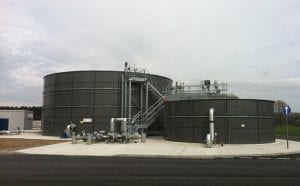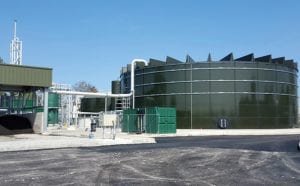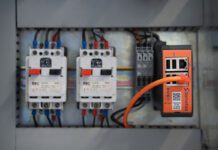Energy self-sufficiency in the water industry is a major incentive behind advanced digestion processes for sewage sludge. But managing high strength ammonia digestate and thermal hydrolysis liquors, a by-product of the process, can potentially undermine the benefits. Peter Brewer, General Manager at ACWA Services, a water and wastewater solutions provider, explores the issues and explains why he believes separate treatment is crucial.

Large scale anaerobic digestion (AD) and related processes like thermal hydrolysis are transforming how water companies are treating sewage sludge, turning what was once a costly disposal issue into a lucrative energy and revenue opportunity.
Increases in efficiency and technical advances have helped, to the point where some plants are not only producing sufficient renewable energy for their own needs, using the biogas produced to generate electricity, but also selling energy back to the grid.
This trend will almost certainly continue as water companies strive towards greater energy self-sufficiency and carbon reduction. When you consider that energy bills equate to something like 50% of a water company’s treatment costs it is not surprising.
However, the economics can be finely balanced and a significant and growing issue is the volume of high strength ammonia liquors arising as a by-product of the process. These must be managed effectively to ensure overall plant operation is not compromised and to meet increasingly stringent discharge consents.
It’s an area ACWA Services has been involved with since the late 1980s working with a number of leading UK water utilities to pioneer its Amtreat technology, a solution that effectively treats high strength ammonia liquor to ensure that the AD process is as economically viable as possible.
Hard to treat ammonia levels
These high strength liquors are typically produced both as a result of the AD process itself and the thermal hydrolysis treatment where sludge pre-thickening and de-watering stages will be employed.

The more effective the advanced digestion process, the higher the levels of ammonia in the sludge liquors. High strength liquors generated by plants using thermal hydrolysis for example can have ammonia levels as high as 2,500 mg per litre, which can be particularly difficult to treat.
In most cases these high strength waste streams are then combined and fed back to the head of the water treatment works for processing. However the ammonia levels of the collected waste stream can be so high they can actually derail the existing wastewater treatment process.
Adding high strength liquor to an Activated Sludge Process (ASP) can also render this treatment less effective – meaning final effluent could have unacceptably high levels of ammonia and the plant may find itself in breach of its consent, with potentially serious repercussions.
A growing challenge
The trend to develop centralised AD infrastructure fed by a series of satellite water treatment works is clearly driving up volumes and load at some sites. But sewage works dealing with local population increases may also struggle to meet targets for ammonia. At the same time restrictions on ammonia levels for treated effluent are becoming increasingly stringent with some permitted levels of ammonia as low as just 1mg per litre. So it’s a growing challenge for the industry. Some plants will clearly be close to their designed operational limits.
High strength ammonia digestate: What are the issues?
• Increasing volumes generated by advanced digestion processes
• Large fluctuations in flow and load
• Inability of existing treatment process to deal with additional load
• Potential for works consents to be compromised
• Limited space and site constraints
Now deployed at six UK wastewater treatment plants, with more in development, ACWA’s approach to ammonia removal is a modified high-rate activated sludge process, designed with familiar water industry operational requirements, to provide treatment of the liquors. This reduces the ammonia and total nitrogen levels within the liqours to a level that can be safely discharged to the head of the existing wastewater treatment process, thus reducing the possibility of consent failures whilst allowing additional capacity for incoming sewage. Separating the treatment in this way provides a contained solution ensuring that the performance of the existing system isn’t compromised. A small footprint is particularly important where space and site constraints, due to existing infrastructure, are potential issues.
Ammonia reduction
With commissioning completed earlier this year Leigh Wastewater Treatment Works in Greater Manchester, operated by United Utilities, is one of the latest plants to benefit. Leigh WwTW acts as a central processing plant for sludge imported from other United Utilities sites across the region, producing energy from advanced digestion. Like other plants dealing with high strength ammonia liquors, including centrifuge liquors from both raw sludge thickening and digested sludge dewatering processes, is crucial.

Designed and constructed by ACWA the new Amtreat plant has a processing capacity of 805m3 per day and is designed to perform full denitrification with a minimum of 95 per cent ammonia removal, the plant actually achieves greater than 98% removal. The plant incorporates the anoxic tank within the Amtreat reactor, plus chemical dosing, settlement tank, stilling tube, pumps, blowers, instrumentation and controls. Ensuring a constant temperature with the use of heat exchangers and boiler means there is no seasonal dependency for the process.
Once the ammonia levels have been reduced, the treated effluent can be fed back into the head of the treatment process without fear of disrupting the smooth operation of the plant. The Leigh ammonia removal plant is the first to have been built by ACWA to co-ordinate with a thermal hydrolysis plant built using Cambi technology.
Anglian Water also benefits from Amtreat technology, providing high strength effluent treatment to complement its heating, pasteurisation and hydrolysis (HpH) plants, at sites in Colchester, Ipswich and Basildon. The Amtreat plant at Colchester, the largest of the three, handles 580m3 per day of high strength effluent with ammonia levels of 1,534 mg/l. Final effluent quality achieved is in excess of 98 per cent ammonia removal.
Managing costs
Advanced digestion to convert waste to energy will continue to be an attractive solution across the water industry. As technology and experience improves its likely that costs will fall and in tandem with this energy production is likely to increase as biogas output and quality improve.
Attractive though this is, it is important that the benefits aren’t undermined by the challenges of dealing with high strength wastewater by products.
As loads increase and plants reach their full capacity their ability to deal with high levels of ammonia is reduced. Even plants which have stayed within their consent levels can run into problems when they expand or are expected to process additional levels of sludge imported from other areas.
Solutions like Amtreat can be retrofitted to existing plants but a far better answer is to install additional ammonia treatment when building a new advanced digestion plant.
Incorporating the Amtreat system into an anaerobic digestion plant means a more stable and predictable process, lower energy bills and less danger of breaking consent levels.
With an increased emphasis on energy production expected in AMP 7, it is more important than ever that anaerobic digestion is managed well and that everything is done to make the process as efficient and as stable as possible.






